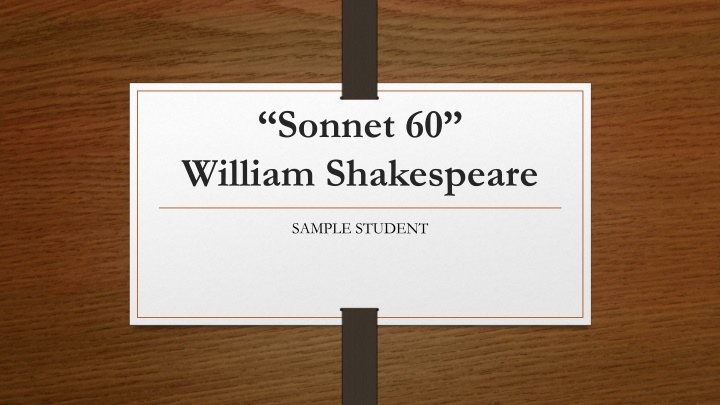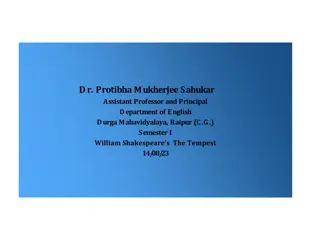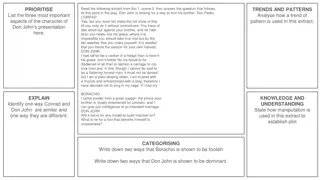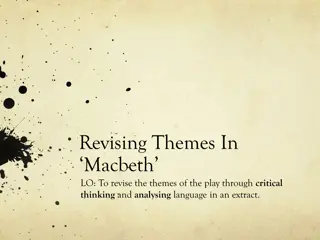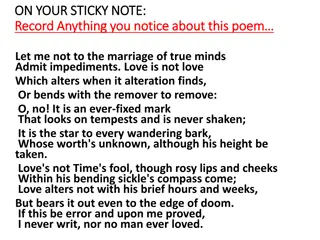Shakespeare's Sonnet 60 Analysis and Insights
Shakespeare's Sonnet 60 is a poignant reflection on the passage of time and mortality. The poem vividly captures the relentless march of time, likening it to the waves steadily approaching the shore. Through concrete imagery and powerful metaphors, the sonnet explores the fleeting nature of youth, beauty, and life itself, ultimately seeking solace in the hope that the beloved subject of the poem may be immortalized through verse.
Download Presentation

Please find below an Image/Link to download the presentation.
The content on the website is provided AS IS for your information and personal use only. It may not be sold, licensed, or shared on other websites without obtaining consent from the author.If you encounter any issues during the download, it is possible that the publisher has removed the file from their server.
You are allowed to download the files provided on this website for personal or commercial use, subject to the condition that they are used lawfully. All files are the property of their respective owners.
The content on the website is provided AS IS for your information and personal use only. It may not be sold, licensed, or shared on other websites without obtaining consent from the author.
E N D
Presentation Transcript
Sonnet 60 William Shakespeare SAMPLE STUDENT
Shakespeares Life April 23, 1564 - April 23, 1616 Learned Latin and a little Greek and read the Roman dramatists as a child 1585 - went to London to begin his apprenticeship as an actor 1594 - joined the Lord Chamberlain s company of actors; performed at the Globe Known for 154 sonnets and at least 30 plays
Shakespeares Writing Style Used a metrical pattern consisting of lines of unrhymed iambic pentameter (blank verse); plays use this pattern Sonnets are written in iambic pentameter Styles were typical of the day; other writings of the time influenced how he structured his compositions
Simple Summary Is a meditation (focus) on mortality (death) Everything that is mortal must perish for our minutes, and the minutes of our remembrance, move ever forward as irrevocably as the waves move forward, beating ceaselessly on the shore Uses concrete images to convey how time passes In the final line suggests one (his beloved) might be preserved from the total oblivion of time's destruction
Sonnet 60 Like as the waves make towards the pebbled shore, So do our minutes hasten to their end, Each changing place with that which goes before, In sequent toil all forwards do contend. Nativity, once in the main of light, Crawls to maturity, wherewith being crowned, Crooked eclipses 'gainst his glory fight, And time that gave doth now his gift confound. Time doth transfix the flourish set on youth And delves the parallels in beauty s brow; Feeds on the rarities of nature s truth, And nothing stands but for his scythe to mow. And yet to times in hope my verse shall stand, Praising thy worth, despite his cruel hand. Hasten: Sequent: Toil: Contend: Nativity: Crooked eclipses: Confound: Transfix: Delves: Rarities: Scythe: Mow:
Poem Analysis - Title Technically doesn't have a title Know it by its numbered position in a series of sonnets Seems to be placed deliberately at this point, as number 60, to coincide with the 60 minutes of the hour
Poem Analysis - Paraphrase As the waves move toward the pebbled shore, so do the minutes we have to live hasten toward their end, each moment changing place with the one before, striving to move forward with successive efforts. Everything that has been born, though it once swam in that broad ocean of light that exists before birth, crawls its way up the shores of maturity, where it faces cruel obstacles to its glory. Time, which gives everything, now destroys its own gift. Time pierces the beauty of youth, drawing wrinkles in beauty s forehead. Time devours the choicest specimens of nature; nothing exists that it won t mow down with its scythe. And yet my verses will last into the future, praising your worth despite Time s cruel hand.
Poem Analysis - Connotation Each of the poem's three quatrains centers on a different set of imagery; each set of imagery illustrates a different aspect of the poem's main theme: the passage of time First quatrain the sea is the image Lines 1-2: a simile that compares time to the ocean Line 4: personification waves are described with human characteristics --- toil" and "contend"
Poem Analysis - Attitude Neutral attitude Sees both the good and bad side of time, accepting it Praising times unfeeling hand in which it strikes down living things
Works Cited Shakespeare s Sonnet 60. Poets.org. Academy of American Poets, n.d. Web. 23 Sept. 2014. "Shakespeare's Writing Style and Metrical Pattern." Shakespeare's Writing Style and Metrical Pattern. N.p., n.d. Web. 23 Sept. 2014.
